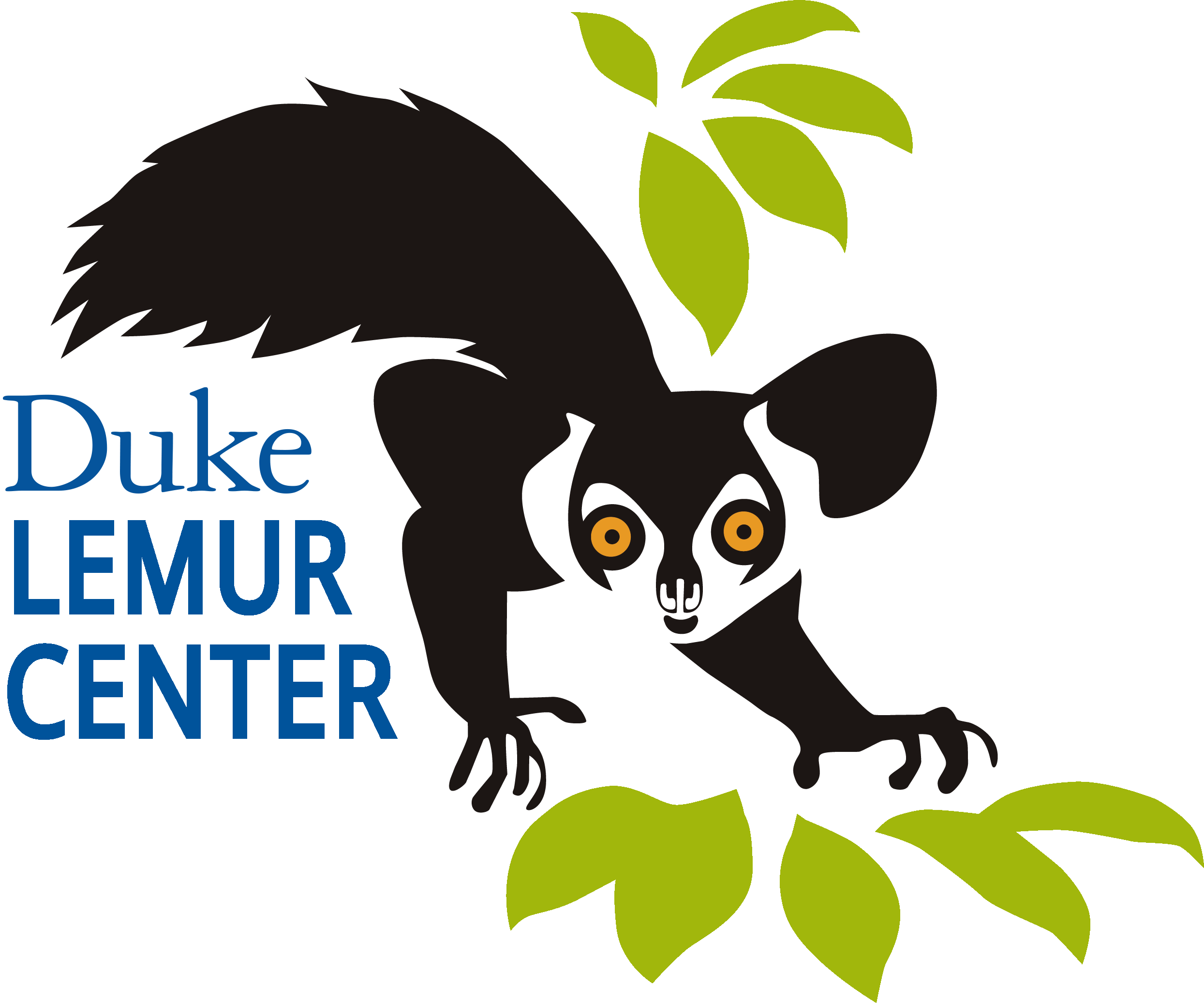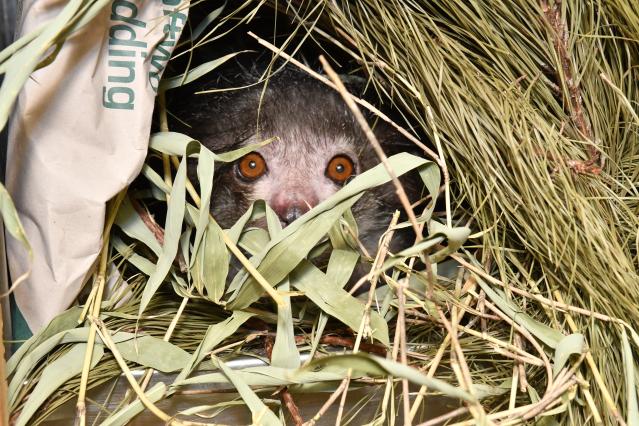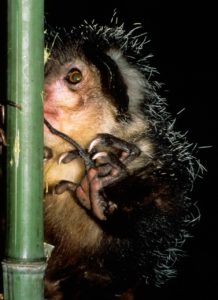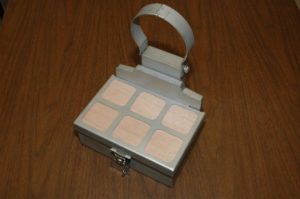Once considered one of the most endangered mammals in the world, the aye-aye has in recent years been shown to be much more widely distributed than originally thought. This is due to the fact that recent years have seen an influx of researchers into Madagascar, including those specifically looking for this rare and elusive animal. Current findings indicate that the aye-aye is sparsely distributed along the east coast and in the northwestern forests of Madagascar.
The main threats to the survival of the aye-aye are loss of habitat and hunting pressure. Unlike many lemur species that are hunted for food, aye-ayes are sometimes killed as crop-threatening pests in agricultural areas, and also because their bizarre appearance has traditionally led many villagers to regard the animal as an evil omen which must be killed on sight to avoid bringing bad luck onto an entire village. Aye-ayes are found in at least 16 protected areas, and several of these locations appear to have healthy populations of this lemur.
Worldwide, the captive population of aye-ayes stands at about 50. As of December 2016, there were 23 captive aye-ayes in the United States: 10 males and 13 females. Of these, nine reside at the Duke Lemur Center and 14 are held at six additional AZA institutions. All but one of these 23 are descendants of the DLC’s original eight wild caught founder animals. An aye-aye pedigree chart can be viewed HERE.
Aye-aye breeding has also occurred at the Durrell Wildlife Park (Jersey Islands), Bristol Zoo, London Zoo, Paris Zoo, Tokyo Zoo, and Frankfurt Zoo.
Median Age in Captivity: 15.1 years
Max Age in Captivity: 29.6 years
Sleep Pattern: Nocturnal. Aye-ayes cannot see in the red light spectrum, use red lights for observations. If needed, a white light can be used briefly to see more detail.
Social: Typically housed solitary, but can be housed in pairs or females with offspring.
Feeding: Omnivorous - fruits, vegetables, insects, commercial monkey biscuit (Mazuri Leaf Eater Primate Diet Mini-Biscuit #5672 and Purina Monkey Diet chow #5038) and proteins (eggs, nuts and insects) make up bulk of captive diet. Feed at least twice per day.
Normal Weight Range: 2500 - 3000 grams
Weighing frequency: Once per month as adults at the DLC; can increase frequency if there is concern about their weight. See Reproduction section for infant weighing schedule.
Sexual Maturity: 4.2 years for female, 3.7 for male
Gestation: 158-172 days
Training: Most aye-ayes are receptive to training and are quick learners. Chopped up nuts work well as reinforcement. Pecans and cashews tend to be favorites. Some individuals will also take dilute honey or peanut butter from a syringe.
To view more aye-aye facts, please visit the San Diego Zoo Global Library web site.
At the DLC, minimum requirements for a room are 270 square feet and 2700 cubic feet per animal, at least 10 feet high. More space is ideal since they are active animals that cover large home ranges in the wild. If you have multiple animals it is ideal to have a shift door between areas so that the animals can be separated easily if the need should arise.
Due to the aye-ayes strong jaws and chewing ability any features in the enclosure that are intended to be long standing should be made of very hard materials such as stainless steel and concrete. Concrete should be a smooth surface as crevices are interesting for aye-ayes and where they often begin chewing. If using chain link for an enclosure, 11 gauge or thicker is used to prevent aye-ayes from chewing through the wire. Panels of stainless steel can be used to protect walls where aye-ayes might chew.
The main structure of the interior in enclosures at the lemur center are made of 4"x 4" western red cedar posts milled into an octagon shape. The posts are connected by 1" x 1.4" galvanized flat steel bars, attached with 3/8" x 5" zinc-coated threaded bolts, lock nuts and washers. The bolts have a partial thread so that only the smooth shaft is accessible if the aye-aye chews around the bolt. The bolts can become loose over time and it is important to check them regularly and tighten as needed.
A variety of natural logs, branching and loose nesting material such as pine and bamboo is added to enhance complexity in the enclosure. Strips of fleece can be used to attach smaller branching and enrichment.
It is important to reduce or eliminate moving parts in the enclosure, especially metal on metal. Aye-ayes in the past have injured their tapping fingers on objects that create a scissoring effect.
Lighting
As nocturnal animals, an institution may decide to keep their aye-ayes on an artificial light cycle so that the animals can be awake when staff and and visitors are present. If that is the case, their light cycle needs to be carefully managed.
At the Lemur Center a modified reverse light cycle is used. When animals are on managed light cycles, the enclosure must not allow light to leak in from other areas during the animal’s dark phase.
During their lights on phase, make sure to use several bulbs to ensure that it is bright enough to simulate daytime light levels and ensure appropriate brightness should a single bulb burn out.
The photo period can be set for whatever time works best for the facility. At the DLC, the dark phase (lights out) begins at 11:00 AM and their photo period matches Madagascar's natural photo period. The following table details the amount of time the light phase lasts in their enclosure throughout the year.
Date Hours of Daylight
Jan 1 12:43
Jan 13 12:40
Feb 3 12:30
Feb 18 12:21
March 4 12:11
March 16 12:03
March 31 11:52
Apr 15 11:42
Apr 27 11:35
May 12 11:26
May 27 11:20
Jun 17 11:16
Jun 29 11:16
Jul 14 11:19
July 29 11:25
Aug 10 11:31
Aug 25 11:40
Sept 9 11:50
Sept 21 11:58
Oct 6 12:09
Oct 21 12:19
Nov 2 12:26
Nov 17 12:34
Dec 2 12:40
Dec 14 12:43
During the dark phase, light levels should be 1 lux or less. Since aye-ayes cannot see in the red-light spectrum, red lights can be turned up when staff are in the enclosure, but should be kept dim as much as possible. DLC staff use head lamps with red lights when its is necessary to see something in greater detail. If necessary, it is okay to briefly shine a white light to get a better look at the animal or the room but be careful not to shine the light directly in their eyes.
At the DLC some individuals have been kept on a natural North Carolina photo period when having outdoor access or living outdoors. If animals also have indoor access, indoor lights are programed to match the local photo period. This approach presents some unique challenges for the animal husbandry staff which never see the animals awake during regular work hours.
The DLC currently has several aye-aye groups that have indoor and outdoor access but remain on a modified reverse light cycle. The enclosures are set up with nest boxes in the indoor rooms only requiring animals to go inside when they are ready to sleep at the end of their awake period. Flood lights are set up outside and turn on several minutes before the indoor white lights turn on, which encourages aye-ayes go inside where it is still dark. There is also a nest box installed on the outside enclosure located at the entrance to the indoor enclosure. If an aye-aye decides to nest, they typically nest in that location. The nest box has a door that can be closed from the outside in the morning giving the animal access to its indoor room but not to the outdoor enclosure.
When staff arrive in the morning the shift door that leads to the outdoors is closed. To date, we have not had problems with aye-ayes building nests in locations besides the nest boxes.
When the white light goes out at 11:00 AM , animals are restricted to indoor access until ~ 4:00 PM when the shift door is opened. They typically do not go outside until later in the evening when it is darker. The white light that comes in through the shift door does not seem to effect most aye-ayes, however, it has caused some individuals to shift their wake-sleep cycles slightly.
Temperature Requirements
The indoor temperature at the Lemur Center is set to ~78 Degrees Fahrenheit. Acceptable temperatures range between 64 - 94 degrees Fahrenheit but should ideally be maintained in the 70s.
Humidity is kept at 30 – 70% indoors, varying seasonally with outside air humidity. Aye-ayes favor high humidity levels and maintaining levels at the upper range year-round is preferred. Low humidity can cause sinus and dry skin problems.
For individuals with indoor and outdoor housing, outdoor access is restricted if temperatures are below 41 degrees Fahrenheit.
Cleaning
At the DLC, aye-ayes are housed in indoor and outdoor enclosures. The indoor enclosures have concrete floors with pine shavings on the floor. The shavings are spot cleaned daily with old food, enrichment, and urine-soaked shavings removed. Paint scrapers are used to scrape debris from branches and shelves. A spray bottle is used to apply water as needed to soften hardened substances. Fresh browse such as pine and bamboo are removed weekly and replaced.
Every two weeks shavings are swept up and replaced. Every six weeks the animals are removed from their indoor rooms while the room is stripped clean and sanitized. It is preferable to shift animals to another room if possible, but if not, animals can remain temporarily in transport kennels while their room is cleaned.
After removing shavings and old browse rooms are sprayed with a soap solution (Simple Green D or Dawn dish soap) and all the branches, surfaces, and floors are thoroughly scrubbed. Then the room is rinsed well with water and dilute bleach is applied to all surfaces in the room. The bleach sits for 10 minutes and is then rinsed with more water. Once the room is clean it is restocked with browse and shavings and the animal is returned.
The outdoor enclosures have a gravel surface that is raked daily. Branches are scraped of old debris as well.
Mixed Species Exhibits
Aye-ayes have a history of successfully living with other nocturnal prosimian species at the DLC including bush babies, fat-tailed dwarf lemurs, slow lorises, and pygmy slow lorises. When introducing separate species make sure to monitor introductions carefully following the same precautions as when introducing members of the same species. More information on introductions can be found in the Reproduction and Infant Rearing section.
The smaller prosimian species may become overweight due to access to left over aye-aye diets so monitoring weights regularly is important. Some individuals of the smaller species have even been observed snatching food right out of an aye-aye's hand while they are eating.
The aye-aye's ability to chew into wood or thick cardboard can be leveraged to help reduce the smaller animal's access to the aye-aye's food but eliminating it is very difficult. Aye-ayes tend to leave a lot of food uneaten and drop scraps on the ground. If the other species is willing to go to the ground to eat uneaten food, they often develop weight problems.
It's important to remember the limitations of materials that aye-ayes can receive for enrichment when living with other species. Providing quality enrichment that is approved for both species simultaneously is a challenging task.
Some institutions are considering housing aye-ayes with diurnal species to utilize space in a more efficient manner the idea being that diurnal and nocturnal species could utilize the same space without significantly interacting with each other. This has not been tried at the DLC to date and it remains to be seen if this approach will be successful for both species involved.
In the wild the aye-aye’s diet is highly specialized and consists mainly of the interior of Ramy nuts, insects and grubs, nectar from the Traveller’s Palm and some fungi. The animals are also known eat coconuts, lychees and mangoes planted for human consumption. Most of what is known about the diet and social behavior of wild aye-ayes is based on a two-year study in the early nineties by Yale University Undergraduate, Eleanor Sterling.
Captive aye-ayes at the DLC have a more structured diet. The main portion of the diet consists of a rotation of different gruel flavors made from softened primate biscuit, fruits, vegetables, insects and eggs or nuts. Aye-ayes at the DLC usually do not eat everything offered each day. However, they very rarely have weight problems. They appear to self-regulate their weight unless given a lot of high calorie or highly palatable foods.
An example of a diet rotation is detailed below:
Daily standard diet per animal:
160 g. gruel + 1 fruit + 1 vegetable + 1 misc. item (weighed out as shown below) and worms.
- GRUEL RECIPE: (ideally fed right after lights go out; this recipe makes enough to feed 2 animals)
~ 75 g. Mazuri Leaf Eater Primate Diet Mini-Biscuit #5672
~ 75 g. cracked Purina Monkey Diet chow #5038
MEASURE and ADD ≤ 2 cups warm water plus flavoring as below.
GRUEL FLAVORING - alternate between flavors
Honey = 2 tsp. Peanut butter = 2 tsp. Syrup (maple/fruit) = 2 tsp.
Applesauce = ¼ cup Cashew butter = 2 tsp. Vanilla extract = 1 tsp.
Almond butter = 2 tsp. Almond milk Coconut cream
Gruel should be offered in a container or feeding mechanism that allows aye-ayes to use their middle finger to scoop the food into their mouth using their elongated middle finger. Options include a closed up cardboard box, a length of hollow bamboo, hollow wood feeders or empty egg cartons. Other containers made of safe materials that aye-ayes can chew into can also be used as well. When using a box, remove any unapproved materials such as plastic from the container and tape the box closed. Another method is to use six pack cardboard containers and hang them from a branch.
Gruel is typically fed when animals first wake up when lights go off. It's typically one of their least favorite food items which is why it is fed first before more desirable diet items. The primate biscuit gruel contains nutrients that are important for the animals' health so steps are taken to encourage them to eat it.
There are a variety of flavor options that have been developed. Individuals seem to have flavor preferences, and some flavors are more popular than others. It is okay to add and remove flavors in the rotation based on how well they are liked.
When preparing the gruel, crack the primate biscuits so that they soak up the liquid more easily. Put all the chow in a large bowl with the hot water and the flavoring. Give it plenty of time to completely soak up all the liquid and stir until it reaches a smooth consistency before placing it in feeders.
WORMS: (Avoid adding worms to gruel, they’ll drown.) 20 wax worms and 40 meal worms = 30 worms for each individual. Worms can be feed in a variety of different feeders to provide enrichment.
The worms should be given in a container that the aye-aye can chew into and extract the worms to promote natural feeding behaviors and keep their incisors worn down. See details on worm feeders in the Specific Aye-Aye requirements section under foraging.
FRUIT:
 Melon, cucumber, and eggs
Melon, cucumber, and eggs

Aye-ayes seem to prefer their fruits and vegetables in large pieces. It makes it easier for them to handle the food and use their tapping finger to scoop the food into their mouth. Geriatric individuals may need certain hard food items such as carrots, apples, and sweet potatoes cooked to make them softer. Even younger aye-ayes seem to enjoy these items cooked for enrichment.
PROTEIN:
In addition to the other food items, a miscellaneous protein item is provided to aye-ayes daily.
Eggs: We lightly boil eggs before giving them to the aye-ayes. Water is brought to a light boil to very lightly cook the white of the egg leaving it still slightly runny with the yolk still soft. Consult with the veterinarian at your institution for the solution that works best.
Aye-ayes prefer the inside of the egg to be soft rather than cooked solid as it is easier for them to scoop the insides of the egg into their mouth. Make certain that the egg is completely cool before providing it to the aye-aye as the outside can feel cool to the touch while still being hot on the inside.
Nuts: A variety of nuts in the shell are provided to the aye-ayes including walnuts, pecans, cashews, peanuts, hazelnuts, and Brazil nuts. For aye-ayes that are unable to chew into the shell, lightly crack the nut with a mallet.
Nuts are a high-value food item and are one of the best reinforcements for training.
Coconut: crack the coconut with a mallet to measure out the proper amount of flesh for a single aye-aye. If possible, save the coconut milk and give as enrichment to the aye-ayes or another species.
Tamarinds: these are given out occasionally as novel food enrichment.
Avocado: Aye-ayes should not receive avocados as they can be toxic. Aye-ayes have died from eating avocados. (find statement about avocados)

Sample diet rotation
Sanitizing Produce
At the Lemur Center all produce is washed for the following day in the morning. Produce is soaked in a dilute bleach solution to kill pathogens that may reside on the outer surfaces of the item, then stored in the refrigerator in a container until the next day when it is prepared for the animals the next morning.
DLC produce sanitation procedure:
- Fill the sink with 20 gallons of cold water (about 1/3 full).
- Add two (2) cups of chlorine bleach and mix well.
- Remove any dirt from produce prior to soaking.
- Add fruit and vegetables (use only uncut food with skins intact).
- Let soak for five minutes (not longer).
- Fill, rinse and drain the sink with water three times to thoroughly rinse food and remove traces of chlorine bleach.
Diets for Pregnant Aye-ayes
When a female is pregnant it is important to ensure the dam is receiving enough nutrition to meet her dietary needs. After infants are born diets are slowly increased based on the weight of the infant. By one year of age an infant typically receives a full adult diet.
- When pregnancy is confirmed, increase the dam's diet to standard + 25%
- At the dam's diet at birth of the infant, to standard + 50%
- When the infant is 3 months old, increase the diet for the pair to to standard +75%
- At 6 months of age, increase to 2 standard diets
Oral Medications
Aye-ayes will generally voluntarily take oral medications when mixing with highly palatable food such as peanut butter and Smucker’s Blueberry Syrup. Medications can either be mixed with food in a small container such as a paper cup or offered in a syringe while they are licking the food and medication off the tip.
Aye-ayes have a variety of needs that must be addressed to encourage natural behaviors and promote psychological and physical well-being.
An aye-aye's front incisors are constantly growing similar to a rodent's. Because of this, they require materials they can chew on to keep their teeth worn down to a normal length. Materials given for chewing also encourage other natural behaviors that are important for aye-ayes to express.
Nesting
Aye-ayes are a species that build and sleep in a nest. At the Lemur Center they are provided with a 16" wide x 16" deep x 20" tall stainless-steel box to build a nest in if they desire. At least one box per animal is required. Some individuals may build a nest on top of the box, on the ground, or nestled into the branching of the enclosure. Most aye-ayes like having a large paper bag to build their nest inside the nest box. Paper lawn waste bags with the sides rolled down until they are a small enough size to fit into the nest box are ideal for this purpose.
Provide a variety of nesting materials they can use to build nests. Any browse that is approved for feeing primates can be provided. Pine and bamboo are the popular materials and are available year-round. Some forms of seasonal browse is also well received by aye-ayes at the Lemur Center including sweet gum, tulip poplar, and grape vine. Provide fresh browse and nesting material twice weekly, and remove old browse weekly. Aye-ayes also enjoy incorporating fleece blankets and wood wool into their nests or as a sole material to sleep in.
Aye-ayes are very limited in the types of materials they are allowed to have in their enclosure at the DLC. They are curious and will chew on almost anything they can access. Materials that can be ingested are unsafe because they can lead to intestinal impaction. Therefore, plastic and cloth material with threads should never be given to an aye-aye. Fleece is the only fabric material approved for aye-ayes at the Lemur Center.
Foraging
Since a significant percentage of an aye-aye’s diet consists of insect larvae that dwell inside dead or living trees, the animals have evolved a specialized method for locating larvae. As they move along a branch, they continuously and rapidly tap the surface with their middle finger. Cupping their huge ears forward the aye-aye listens intently to the reflected sound waves from the tapping, a method termed echolocation. When the sound indicates they are above a hollow area or tunnel in the wood, the animal begin to tear off chunks of the outer bark with their incisors until the insect tunnel is revealed. Then the aye-aye inserts its slender, highly flexible middle finger into the hole. When the prey is located it is hooked with the tip of the nail and extracted from the tree.
One way to encourage this behavior in aye-ayes in captivity is to provide worms or other food items inside hollow wood, cardboard, or other containers. The Lemur Center has three primary forms of wooden feeders:
- Wood block (insert pictures). A narrow rectangular wooden pine block has a half inch hole drilled down the middle into which the insects or food item is placed and a half inch diameter wooden dowel cut into i/2 inch long lengths is used to plug to the hole.
- Bamboo segment: One and a half to two inch diameter bamboo stalks are cut into 8-10 inch length segments. A quarter inch hole is then drilled into the side of each segment. The worms can be inserted through the hole one by one. Afterwards the hole is plugged with raisins, peanut butter, or chunks of fruits or vegetables to prevent the insects from escaping. Some aye-ayes won't chew into the bamboo and will scoop the worms out through the pre-drilled hole instead. To avoid this and encourage chewing, drill the side holes near the end of each segment of bamboo rather than in the middle.
- Metal six pack feeders (insert pictures). These metal feeders were custom made for the DLC. We use sheets of 1/4 inch thick pine sheets to cover the top of the container.
Geriatric aye-ayes may need their worms delivered in softer containers made from cardboard or paper. Paper bags, cardboard tubes, cardboard boxes and paper cups are all good options. Some older aye-ayes lose interest in insects when they are in their late twenties.
Aye-ayes also enjoy partially decayed logs. Fallen logs or branches that are slightly decayed encourage aye-ayes to tap and chew into the logs looking for insects. A branch as small as 3 inches in diameter can contain grubs or other insects. It does not have to be a large log to be interesting to an aye-aye. A decayed log can occupy an aye-aye for long periods of time. Be careful to avoid logs that contain colonies of ants and bringing them into indoor enclosures. Inspect logs carefully before putting it into the aye-ayes enclosure.
Choosing logs that aye-ayes like is more of an art than a science. Freshly fallen logs are not likely to get much attention from an aye-aye. If the log still feels dense and heavy it is not sufficiently decayed. When insects move into logs the weight of the log typically becomes lighter. There is anecdotal evidence that pine trees are the preferred species of the aye-ayes at the Lemur Center although any sufficiently decayed log is acceptable.
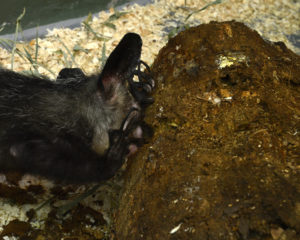
Dental
Aye-ayes are prone to tooth root abscesses in their incisors. It is most common in older aye-ayes but can happen at any age. The roots of the aye-ayes incisors are extremely long and extend on the lower jaw back to the angle of the mandible. When an abscess occurs the animal develops a lump on the side of its upper or lower jaw. Incisor tooth root abscesses most commonly form on the lower jaw but can also occur in the upper incisors. An aye-aye's face should be inspected daily for abnormal swellings or lumps. Alert the veterinarian if seen as medical intervention will be required.
Older aye-ayes or ones that don't chew much often need help keeping their incisors from growing too long. Incisors should be 12-14 millimeters long. If their incisors get too long, aye-ayes have trouble eating and chewing normally and need to have their teeth ground and reshaped by a veterinarian under anesthesia with proper dental equipment. It can be difficult to visually determine if an individual has overgrown teeth. Some individuals have incisors protruding from their lips but that is not always an indication that their incisors are overgrown.
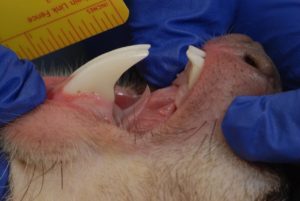
Normal aye-aye incisors
Handling and Restraint (Note: do not attempt to manually handle or restrain aye-ayes without appropriate training to avoid injury to the handler or animal)
As with all captive animals, aye-ayes may need to be moved or restrained periodically for enclosure maintenance or veterinary care. Whenever possible, aye-ayes should be trained to voluntarily enter a transport kennel, position for exams and injections and other common husbandry procedures.
At the DLC, aye-ayes live in large rooms and netting awake animals is only done as a last resort and only if it's critical to get an individual in hand immediately.
Our preferred method for manually restraining aye-ayes is to get them out of their nest while they are asleep before their white lights go off for the day.
The staff member doing the restraint should always wear arm protection (Kevlar sleeves) and protective gloves. Backup handlers wear the same PPE and has a net to assist the handler if needed.
Because manually restraining aye-ayes posses risk of injury to staff and animals and is stressful for both, it is important that it only be done by individuals well trained in the process. If you have questions about how the DLC trains staff to handle aye-ayes contact the DLC's Curator or Assistant Curator for more details. If you would like more information on training aye-ayes for husbandry and veterinary procedures contact the DLC's Curator of Behavioral Management and Welfare.
Duke Lemur Center Pinterest Page
The Pinterest page contains many Lemur Center approved enrichment ideas. Not all the enrichment on the page is suitable for aye-ayes.
Enrichment is given to provide sensory stimulation, and encourage physical activity and natural behaviors. When animals live in controlled environments, enrichment is important for encouraging natural behaviors and providing mental stimulation.
Enrichment given to aye-ayes needs to be carefully reviewed for safety. As mentioned in other areas of the guide, there are many materials that aye-ayes should not be offered for safety reasons including plastic, rubber, and most fabrics except for fleece.
All items need to be examined for moving parts that can produce a pinching or scissoring effect. Aye-ayes explore objects with their tapping fingers, which are very fragile and are easily broken or cut.
Estrous
Aye-ayes are non-seasonal breeders. For most individuals estrous occurs approximately every 40 days. It is easy to track estrous by observing changes in their vulva. The Lemur Center uses a chart to track estrous daily, using a key to standardize the stages of estrous.
aye aye estrous cycle data sheet revised Dec2010
It's easiest to check them while a female is perched on a branch slightly above the caretakers head while being offered a desirable food item. When below the animal briefly shine a white light on the vulva to check for changes. Most individuals do not mind this but some might take time to get used to it. Some individuals take the food item and go somewhere else. If that occurs try giving smaller pieces so the animal stays in a location the caretaker can easily view the vulva.
When entering estrous, a female's vulva begins to swell and becomes increasingly dark pink over the course of several days until they reach the peak. At that point the female is in full estrous and receptive to the male. Females are in full estrous for approximately 24 hours. Copulation usually occurs during the lights on phase. Both aye-ayes will likely be awake during unusual hours when a female is in estrous. Males may be outside of the female’s nest box for hours at a time.
At the Lemur Center, we document any breeding behaviors observed including copulation and genital swelling, to help determine the due date of the infant should the female conceive. The projected due date is calculated based on the gestation period from the date of breeding or the peak of the estrous if copulation is not observed. (get pic of breeding behavior chart, example pictures of each stage)
Introductions: Male-Female
Introductions are conducted in a manner that puts safety above all other considerations. Two staff members watch introductions for up to several hours until the individuals are compatible. DLC Staff that are present for the introduction are equipped with personal protective equipment (PPE) if intervention is required. At the DLC, staff wear Kevlar arm guards and protective gloves during introductions. We also keep nets in hand at first should intervention be required. (get pictures of PPE and someone geared up)
Aye-ayes should be separated if aggression and chasing occurs. If there are extended bouts of chasing causing one or both individuals to open mouth breath, they should be separated.
If aye-ayes come into contact and ball-up or fall to the ground, they should be separated. If the animals don't separate within 5 seconds, staff needs to intervene and separate them. At the DLC, it is standard operating procedure to examine animals for injuries and wounds after physical conflict.
Aye-ayes should have some form of visual, scent, or auditory access to each other before being introduced to become acclimated to each other's presence.
The best time to start an introduction is when a female is in estrous. She is more likely to be receptive to the male however, introductions can be done any time. Males need to have sufficient space to escape as needed and get out of the female's view.
At the beginning, interest between the two individuals may be low. It's not unusual for the animals to swap enclosures and explore each other's room before interacting with each other. The female is often guarded at first and may lunge at the male and chase him away. The male should respect this and back off whenever she does this. This behavior typically relaxes over a period of several days.
If negative interactions increase in frequency, animals should be separated before the behaviors escalate to a point where animal well-being is at risk. Always end on a positive note rather than a negative one. Another introduction can be done the next day.
Introductions usually only last 1-2 hours to avoid animals becoming stressed or tired and increase as they become more comfortable with each other. When making new pairings or introducing new animals it is important to consider their behavioral compatibility even if they aren't getting into physical altercations. If the individuals are getting along well, staff should reconsider whether the pairing is in the animals' best interest.
When introducing a female in estrous, if introductions do not improve by the end of the her estrous, introductions can be halted and resumed when she is next in estrous.
Breeding Behavior
When estrous begins, behavior will change subtly until the point the female becomes receptive to the male's advances.
Females spend more time urine marking her environment. Males spend more time closer to the female and vocalizing ("eep"-ing). The male may attempt to mount the female before she is ready; if that occurs, she will chase him away.
Aye-aye male "eeping" at female in nest.
Breeding typically occurs over the course of 24 hours and regularly takes place during the light phase of their day. Copulation may occur several times and can last for several hours.
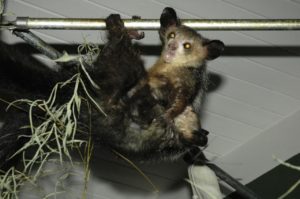
Male hanging from female in classic breeding position.
The classic aye-aye copulation position is for the female to hang upside down on a branch with the male clasping his hind legs around hers and wrapping his arms around her chest or grabbing her arms with his hands. Inexperienced individuals may struggle at first but seem to pick it up within a few estrous cycles.
Birth and Weighing
Prior to delivery, it is important to offer a variety of browse materials for the females to build a nest. Make sure the dam's environment is calm and quiet to reduce stress. Offer pine, bamboo, fleece strips, and any other materials the dam likes. If she is stressed, she may carry or move the infant between nests excessively which can limit weight gain. Provide the dam with at least two nest boxes to choose from. The dam may choose only one nest or may move the infant between nests occasionally.
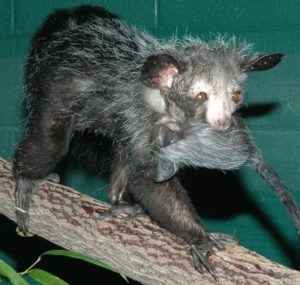
Dam carrying an infant.
Gestation lasts approximately 158-172 days. The birth date of the infant can be predicted within several days based on either the observed breeding date or estimated from the peak day of estrous (if copulation was not observed). At day 158 check the nest daily for the presence of the infant
When the lights go out in the dam's enclosure it becomes more apparent whether an infant was born. If she has had the infant, the dam will typically not leave the nest as normal. If she stays in longer than normal, it is likely the infant was born. If she leaves the nest, check the nest for the presence of an infant.
Infant will stay in the nest until they are old enough to move around on their own. They are usually no seen out of the nest for the first several weeks unless the dam is moving it. If a dam moves her infant excessively between nests, one may be removed for a short time to encourage her to stay in one nest. If a dam moves the infant 1-3 times a day it is not a cause for concern, but she carries the infant much of the day then the infant it is not having sufficient time to nurse and may get cold.
At the Lemur Center infants are weighed on days 1, 2, 3, 5, and 7. If the growth curve looks appropriate then infants are weighed weekly for the next 5 weeks. Infants should gain several grams a day, although it is not unusual for them to not gain or lose 1-3 grams between the first and second day. After that infants should start gaining weight steadily. If the infant is not gaining weight appropriately it may need to be weighed more frequently and be checked by a veterinarian.
Weighing Schedule for Infants:
Week 1: weigh at days 1, 2, 3, 5, 7
Weeks 2-8: once weekly
Months 3-6: every 2 weeks
Over 6 months: once a month
Before weighing the infant have all equipment and staff prepared to minimize the time the infant is away from the dam. Set up a scale with a container lined with a fleece blanket for the infant’s comfort. The scale should be accurate to the gram. Ensure any other essential staff such as veterinarians are nearby or on call as well.
Weigh during the light phase when the dam is in the nest with the infant. Give the dam a high value item such as peanut butter or honey in a cup to keep the dam occupied while a staff member searches for the infant in the nest. It may take some trial and error to determine what she likes as females frequently have a temporary change in food items after having an infant.
Staff carefully search the nest with their hand until the infant is located. Once it is located, carefully grasp it around the torso and gently remove it from the nest. Quickly weigh the infant, do a quick visual inspection of its entire body and return it to the nest. The whole process should take less than 2 minutes.
The first several weights may take a little longer depending whether the veterinarian wants to examine the infant. The veterinary staff at the Lemur Center does a thorough inspection and checks vitals on the infant during the first weighing. The vet staff may also want to examine the dam to check her health and the presence of milk. Remove the infant first and keep it warm while the dam is being examined. Return the infant to the nest right before the dam is ready to go back. The dam can be released into the room and will return to the nest on her own.
If the infant is not gaining weight appropriately, extra steps may need to be taken. Consult with vet staff to develop a plan for examining the dam and infant, determining the cause and whether intervention is needed. All efforts should be made to avoid permanently removing an infant from a dam for hand raising. Infants can be removed from the nest temporarily for supplemental feeding several times a day if necessary then placed back in the nest with the dam as soon as the feeding is completed.
Post-Birth Care
After delivering the infant the dam will spend most of her time in the nest with it for the first several weeks. It's possible that for the first 1-2 weeks, staff may not see her out of the nest. She will likely only come out to eat and stretch her legs for a little while. If she is not spending the majority of her time in the nest with the infant, she may be neglecting it. The best way to determine if the infant is thriving is by tracking its growth curve with frequent weights.
Keep track of what the dam is eating. Many dams become more selective of what they consume and may reject food they would typically eat. It is okay to give extra amounts of their favorite foods for the first few weeks until their appetite returns to normal.
After the first couple weeks the dam will likely be observed coming out of the nest more frequently and start engaging in normal behaviors.

A juvenile explores the outside of the nest.
At 6-8 weeks the infant will begin venturing outside of the nest in small bouts. Initially, they start by sitting just at or near the edge of the nest for a few minutes at a time. It's helpful for them to have a surface on the edge to sit on. There is a possibility an infant may fall so putting extra padding on the floor below the nest can prevent injury. Fleece blankets, browse, or pine shavings are all viable options. Put up a network of small branches right outside the nest once infants begin appearing at the edge of the nest to help them navigate.
Around this time, the dam can be removed from the room and placed in a kennel with the infant if necessary for sanitation or maintenance purposes. Place the kennel in a quiet room while keeping the same light cycle as normal.
When the infant is out of the nest, the dam may become aggressive towards people in the enclosure. It is best to proceed with caution until the staff determines her attitude. If she starts drumming or lunging at staff, it is best to leave the enclosure.
About 2-3 weeks after the infant begins leaving the nest, they become increasingly mobile. Make sure there are lots of branches set up to make it easy for them to climb. Branches that are thin in diameter are ideal - about 2-3 inches. By 2 months of age, they should be getting around the enclosure pretty well.
Once an infant is 3 months of age, it will probably be spending at least an equal amount of time out of the nest as in it. It will also likely start sampling food during this period of time so make sure all food is presented in locations where the juvenile can access it.
For the next several months infants will continue to rapidly grow and develop. By the time they are 6 months old, they are awake and active nearly as much as an adult with some bouts of inactivity throughout the day. They eat solids consistently and are interested in the food their mother has, although she may not be interested in sharing it.
Also, at this age, it is common for young aye-ayes to be very rambunctious. They may huff at humans in the enclosure or charge and swat at them. Try not to react to this behavior and it will likely dissipate over time.
At 6 months of age start providing juveniles with weekly Vitamin D supplement to prevent the development of rickets. The dam’s milk is low in vitamin D and before infants consistently eat gruel they can become deficient in this nutrient. Symptoms of vitamin D deficiency and rickets includes abnormal bone growth, bone fractures, and abnormal growth and stature. Animals may be lame or reluctant to move due to muscle pain, poorly formed bones or fractures.
What is normal behavior?
Most aye-ayes are curious, high energy individuals who spend most of their day on the move. They are often in motion when awake and will frequently stop to look around, sniff, or tap and chew on branches or other objects and are engaged with their environment. Aye-ayes are alert and sensitive to sudden movements, loud or unusual noises, or the presence of unusual objects in their environment.
Aye-ayes at the Lemur Center are desensitized to the presence of humans. When a staff member enters their enclosure, an aye-aye is likely to approach and investigate but usually resumes normal activity after a short period of time. Individuals may become alarmed or stressed by loud noises or excessive activity in their area.
Aye-ayes are a prey species and may become alarmed if they see or hear anything unusual. When they are alarmed they may freeze in place and their silvery guard hairs will stand on end making them appear much larger than normal. When highly alarmed they vocalize and emit a noise called drumming. This may last for several minutes before the individual relaxes and resumes normal behavior.

An alarmed aye-aye
Aye-ayes frequently self-groom throughout the day especially when first awake. They use their tapping finger to groom different parts of their body and may hang upside down from their hind legs to use their forelimbs to scratch and groom. Aye-ayes do not have a tooth comb like other lemurs and do not engage in mutual grooming to the same degree that other lemur species do.
Sometimes an aye-aye squats on the floor or a shelf for long periods of time without moving (30+ seconds) when urine marking. When finished they will resume normal activity. Aye-ayes also urine mark on vertical branching or rub their anogenital area on branches or objects in the room.
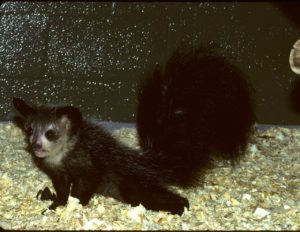
An aye-aye urine marking.
Watching for Illness/Unusual behaviors
There are specific behaviors to look for to indicate if an aye-aye is not feeling well.
Lethargy is often the first sign of a problem. While it isn't unusual for an individual to spend time resting, it is abnormal for aye-ayes to spend large amounts of time sitting still. In addition to spending less time moving, an aye-aye may sprawl over a branch with their head resting on it. This can be a sign of pain, discomfort or weakness. If seen, notify the veterinary staff and closely monitor the individual.
Aye-ayes are generally good eaters in captive settings. As long as they are fed appropriate high quality diets, staff should be concerned if an individual's appetite decreases multiple days in a row and notify the vet staff if their appetite is unusual. Try offering favorite items to gauge interest. It is recommended to watch animals when diets are first offered to monitor their appetite.
It is also important to regularly monitor their fecal output and stool consistency. Aye-ayes pass small pellets about the size of garbanzo bean. Normal stools are firm and oval to round in shape and can be flattened easily with gentle pressure. Notify a veterinarian if stools become runny or soft.
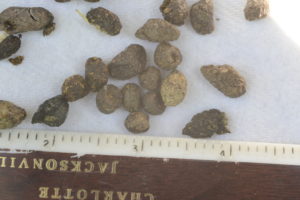
Aye-aye feces
Social Management
Although aye-ayes are primarily solitary in the wild they come together at different stages of development and interact while foraging. In captive environments individuals are sometimes housed as mother-offspring pairs or male-female pairs.
Some practices are helpful for managing social pairs. Always spread their diets around the enclosure to minimize competition. Food can be placed at different heights, in different rooms and in multiple locations. in each room. This prevents the dominant individual(s) from monopolizing all the favored food items. Make sure to observe during feeding to ensure that all individuals are getting access to food and weigh regularly to monitor their weight.
Provide extra nest boxes when animals are housed together. Breeding pairs are unlikely to share a nest box and may not sleep near each other. At the DLC, breeding pairs will have two rooms, and most of the time, the individuals sleep in separate rooms.
If possible, it is helpful to provide visual barriers so that subordinate individuals can get out of view from dominant individuals. Providing a lot of browse can act as visual barriers or staff can hang fleece blankets or other wide items to block visibility.
Spreading food, providing multiple nest boxes and visual barriers, and increasing space are all helpful in reducing social tension.
Group Dynamics
Even in groups that usually live together harmoniously, it is natural for there to be instances when females assert their dominance and for males to be subordinate. Females may lunge at or briefly chase the male. The male should respond by backing off or running away. If the female chases the male, it should only last for a moment with the male leaving the room briefly.
Mother-child pairs typically get along well for several years and sleep in the same nest box until the infant is older. Note whether or not they are still sleeping in the same nest box as sleeping separately may be an early sign that social bonds are starting to break down. Mothers are typically very tolerant of the youngster's behavior. Juveniles may take food from the dam and she will typically allow it without aggression.
Training
Aye-ayes are very receptive to training and can start at a young age once they are comfortable taking food from staff. They are very food motivated and have a long attention span. At the DLC training sessions that last over 8 minutes with some individuals. Keep training sessions free from distractions as once an aye-aye becomes distracted it can be difficult to regain it's attention and focus.
Most of the aye-ayes at the Lemur Center will train for chopped nuts or dilute honey or peanut butter delivered in small amounts from a syringe. Pecans, cashews, and walnuts seem to be the most highly valued. Most aye-ayes are gentle and can take a small piece of food from between the trainer’s thumb and index finger with their incisors. If the pieces are too big, it slows a training session and individuals may take a larger reward and eat it somewhere else before returning to the trainer. Of course, every individual is different, and the trainer will have to determine what works best for each aye-aye.
